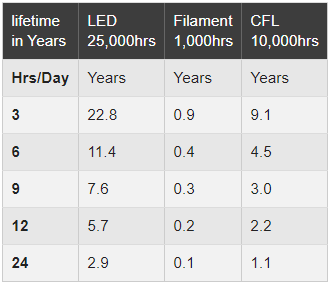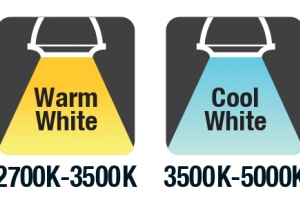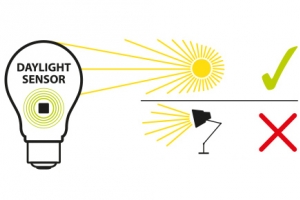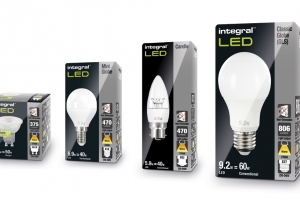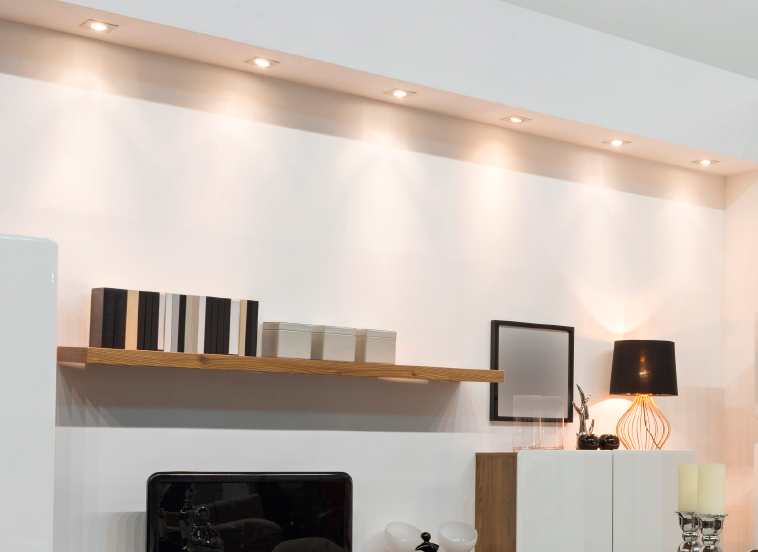Please use the search bar or scroll down to find information about our products or LED lighting in general. We hope you’ll find the answer you’re looking for. If you still need assistance, don’t hesitate to contact us using the contact us form.
LAMPS/BULBS
Will my current dimmer work with LED bulbs?
When using LED bulbs with dimmers that have been produced for conventional lamps - there can be a mismatch in technology, that can cause issues like flickering; Your existing dimmer may have been designed to dim high-power circuits, whereas LED lamps are low-power products. You should change your existing dimmer for a dimmer designed to work with LED.
- Are you using a non-dimmable lamp with a dimming circuit?
- Using a non-dimmable LED bulb in a dimming circuit can cause damage to the LED bulb and/ or dimming circuit. Integral packaging and lamps are marked with text or an icon as non-dimmable or dimmable.
- Your existing dimmer switch may be incompatible with the dimmable LED lamp you have purchased.
- A common reason is that the LED bulb power load is below the minimum load required by the dimmer. e.g a dimming circuit for a 60W bulb may be installed with a dimmer with a minimum load of 25W. A replacement LED bulb may only be 5-6W falling below the minimum level required by the dimmer.
- Incompatible transformer.
- If you are using low-voltage lamps (MR16 12V Spotlight) your existing transformer may not be compatible with your LED lamp.
We would advise you to use a qualified electrician to make any changes to your electrical circuits.
How long will an LED lamp last?
The lifetime of a LED lamp is defined in hours. As with all types of lamp, the light output very slowly fades over time. LED lamps do not generally burnout they will still perform after their rated hours e.g 25,000 hours.
The lifetime is the figure stated when the light output is predicted to drop by a significant amount of the original light output where you may consider a replacement, this is partly due the the slow aging of the parts of the lamps such as refractors and other components. External factors such as heat, humidity, switching cycles and power supply will affect the lifetime of an LED lamp.
The table below gives an indication and comparison with filament and CFL lamps on how many years a LED lamp rated at 25,000 hours will operate.
As you can see a LED lamp will last over 22 years (at 3 hours per day) against a filament lamp of less than a year and a CFL of just over 9 years.
The longer life of LED means less time spent on lamp changes (important for hard-to-get-at areas) . Also it's great for the environment with less lamps, packaging and transport energy being used.
Switching cycles
All lamps including LED have a number of switching cycles. This is the minimum number of times the bulb can be switched ON and OFF before failure in normal use, lamps may go on to last longer. For a typical value of 12,500 the lamp can be switched ON and OFF once a day for a minimum of 34 years! (Environmental factors such as temperature can affect the value). In general, LED lamps for home or office use are not designed to be switched ON and OFF rapidly.
lntegral LED lamps will fit most existing light fixtures.
Integral LED lamps can be used as direct replacements for most of your existing lamps. It's as quick and easy as replacing a conventional bulb.
All the common base types are available in the Integral range, we are very retro-fit friendly.
The Integral LED team have chosen our LED lamps very carefully, so that they are physically very close in physical dimensions to the traditional bulb shapes that they replace. They should blend in with your light fittings better than some CFL energy saving bulbs that can protrude and can look unsightly.
What do "Warm White and "Cool White" mean?
With LED lighting, especially spotlights you may have the option to choose the "light colour", known as " (Correlated) Colour Temperature (CCT) ". Two examples are "Warm White" and "Cool White". There are no rules - the choice is about personal preference and use. CCT is expressed in Kelvin (K).
- A Warm White Integral LED lamp will provide a traditional yellowish colour light, similar to conventional bulbs. This is the most popular choice. (2700-3000K)
- A Cool White Integral LED lamp will provide a modern, clean, bright light, that is slightly blue in colour.(4000-5000K)
Fitting a LED bulb is like fitting any other bulb.
Fitting an LED bulb is the same as fitting any other bulb – but you will have to do it less often!
Before you change a bulb please ensure you have a similar LED replacement with the same base fitting, shape and light output.
Before changing or inspecting a bulb always turn OFF the power at the mains. Please take the necessary precautions if working at height. Wait for the current lamp to cool if required. Carefully remove the current lamp making sure you keep safe any clips or fittings. Fit the new LED lamp and switch the power ON and think about the energy savings you are making when compared to a conventional lighting. Sometimes a new light source may take a couple of days to get used to.
Lamps should be changed by a competent person. Please contact a qualified electrician if in doubt or to make any additions or changes to your circuit.
Dispose of old bulbs responsibly, especially CFL lamps that may contain mercury. Bulbs are not normally disposed of into the normal domestic or commercial waste stream, if in doubt check with your local authority.
How does the Integral Auto Sensor lamp work?
The Integral Auto Sensor lamps are available in two fittings:
Large Bayonet (B22)
Large Screw (E27)
The lamp will switch ON at around dusk when the daylight intensity level drops to less than 80Lux +/- 30% it will switch OFF at dawn when the daylight intensity level reaches 300Lux +/- 30%. On overcast, stormy or dull days the light may stay on a bit longer. On average there will be around 12 hours of darkness over a year - Using a LED lamp will lead to significant savings on energy when compared to a conventional lamp. Ideal for turning your existing external light fitting into switching ON and OFF automatically - just by changing a bulb.
- The lamp has two sensors to give 360 degree coverage – make sure that at least one sensor can “see” daylight
- The auto sensor lamp has been designed to work in suitable external clear glass or plastic fittings - some shades may affect the operation of the lamp.
- There is no warm up time as the lamp is instant on
- The lamp has been designed for suitable outdoor lamp fittings such as porches
- Once the lamp is safely installed, make sure the power is continuously applied to the lamp
- The lamp has been designed to see natural daylight and will not work indoors with artificial light
- The lamp does not have a PIR sensor to sense movement
- The lamp is non-dimmable so cannot be used with a dimmer switch
- The sensitivity of the lamp to daylight is fixed and cannot be adjusted
- Functionality may be affected if your fitting is on a PIR or other detection circuit
- For the lamp to function if must be powered. The light switch must be on the ON position
GENERAL LIGHTING
Integral LED products are instant on - there is no warm up time.
Integral LED lamps are "Instant On", they light up instantly, just like conventional bulbs. They have no annoying warm-up period unlike most CFL bulbs. With LED lamps you enjoy a better performance whilst saving money.
What is the warranty period of Integral LED products?
The warranty provided by Integral LED varies depending on the product you have purchased. The majority of Integral LED products have a 3 year or 2 year warranty.
The warranty period is clearly displayed on the packaging and website (product page and pdf spec sheet).
Integral LED products do NOT contain mercury - unlike some CFLs
LED lighting does not need mercury to be used as part of the lighting process, unlike some CFL bulbs. Integral LED lamps do not contain mercury or any other hazardous chemicals or materials.
Can I use dimmable LED bulbs / lamps with just an On/Off switch (without a dimmer)?
Yes - This is a good idea if you are thinking of upgrading to a dimmer in the future. Ensure you buy a LED compatible dimmer. We recommend the VARILIGHT range of LED dimmers. Non-dimmable bulbs should NOT be used with a dimmer.
STRIPS
What is LED Strip Lighting?
An LED strip consists of a Flexible flat substrate (strip or tape) containing electrical tracks on which LEDs are placed at regular intervals. This flat substrate typically has an adhesive backing tape for easy installation. Once installed and a low DC voltage is applied (typically 12V or 24V) the whole length of the strip is illuminated. LED strips make a great addition to any domestic or commercial environment. They are inexpensive, easy to install and can change the look and ambiance of a space instantly.
The options are endless; the appropriate LED strip can be installed indoors or outdoors for various accent lighting in almost any area. The different levels of brightness and colour types available make LED strips very versatile.
LED STRIP BASICS
- Integral LED low voltage strips are rated at 12V DC or 24V DC and require a constant-voltage driver (a type of transformer to convert mains AC voltage to 12VDC or 24VDC)
- Integral LED strips are supplied in reels of 5 metres or 10 metres. The LED strip can be cut to length but only at special cut points marked on the strip. For example in a kitchen with two runs of 2.5M, you would cut the 5M strip in half (at the cut-point), apply the strip and power each strip with an appropriate driver or power both from the same driver. The strip could also be cut into a number of variations e.g. 4 metre only, 5 X 1 metres, a 3 and 2 metre strip
- More than one strip can be powered from a single driver (The total wattage of the strips (Length x W/m) must be below 80% of the wattage rating of the 24VDC driver and below 90% of the wattage rating of the 12VDC driver)
- Integral LED strips can be dimmed with the appropriate driver and compatible dimmer switch
What do I need to consider when installing LED Strip Lighting?
The following should be considered for any installation of LED Strip Lighting.
- Decide where the strip will be placed and if it will be used for ambient or accent lighting
- LED strips should be installed on a smooth, stable surface that is clean and dry
- How much light do you need? Different types of light output are produced by varying the size, number and colour of LEDs on a strip
- Choose the appropriate IP rating for the area of installation (IP65 or IP67 for bathrooms or outdoors).
- Consider whether you need to conceal the strip, driver and cables
- Consider whether the strip will be always on or switched on and off and decide if it will be part of your lighting circuit or on a separate switch
- The final lighting effect will depend on a number of factors including; Size of LEDs, number of LEDs per metre, the angle and position of the strip, the colour temperature, distance and reflectiveness of surfaces and the distance of the observer from the strip. Know what you want and plan your installation accordingly
- Handy tip: You can evaluate an LED strip by temporarily installing it with a removable tape such as masking tape, and then safely powering it to view the light output, pattern and angle, before finally fixing the strip
- LED strips and drivers must be installed by a qualified electrician
Where can LED strips be installed
LED strips can be installed in a wide range of residential and commercial environments. Popular install locations include:
- Above and under kitchen/bathroom cabinets
- In kick-panels and skirting
- In ceiling coving, as wall washers and around bar areas
- In cupboards, display cases and bar counters
- Around doorways, windows, stairs and embedded into flooring
- Under roof soffits
- In gardens, pathways/driveways and signage
- Lighting for Christmas or other special occasions
- On the rear of TVs, speaker systems and certain gaming machines
What do IP Ratings mean for LED Strip?
Ingress protection determines if an electrical product’s exterior case or enclosure will protect the working parts from water, dust or solid object intrusion, keeping the product electrically safe and lasting longer. Ingress protection testing, or IP testing, provides a repeatable test standard to compare the enclosure protection; IP testing should always be performed at an accredited test laboratory.
Integral offer strips rated to IP20/IP33 (Non-waterproof), IP65 and IP67:
- IP20/IP33 - Not waterproof. This is standard uncoated strip. Use in dry and dust free areas such as ceiling coves, display cabinets, wall washers, bedroom and living rooms (indoor).
- IP65 – Splash resistant - The PCB, LEDs and other components on the top of the strip are coated with silicone, providing protection against dust and splashing water. Typical interior uses are in bathrooms or kitchens, under cabinets and in places where there is a chance that people will have contact with the strip. The cable and driver used when installing an IP65 strip must have an IP65 rating.
- IP67 - Water resistant - This strip is protected with a silicone gel against temporary immersion in water between 15cm and 1 metre. Excellent protection for indoor and outdoor use. Typical interior uses include bathrooms or kitchens, under cabinets and near showers or sinks. Typical outdoor uses include pathways or walls. In addition to the self-adhesive tape; Integral LED IP67 strips are supplied with mounting clips to secure the strip. IP67 strips should NOT be continuously immersed in water. The cable and driver used during installation must also have an IP67 rating.
What is the operational temperature of LED strip?
Integral LED strips are built to suit a certain range of operation temperature (-25°C to +45°C). Please refer to the specification of the strip model you choose.
Integral LED strip will get hot during operation, we advise that the strip is positioned where it cannot be easily accessed by children or adults carrying out everyday tasks.
What difference does LED size and LEDs per metre make?
LED Size
The LED strips can be manufactured and built with different sizes of LED chips. The code simply indicates the actual size of the LEDs on the strip. Integral LED strips are available with several sizes of LED. Below we explain a few common sizes of LED chips on the market.
- 3528 – 3.5mm X 2.8mm LED - Subtle light - Ideal for most domestic situations for accent or ambient lighting where observers are close e.g. ceiling coves, under-cabinets, on stairs and around windows
- 5050 – 5.0mm X 5.0mm LED - Bright light - 40% larger than 3528 LEDs with a higher light output. 5050 LED chips are also a common size for RGB or RGBW colour changing LED chips. Ideal for commercial or domestic use where the observer may be further away – e.g. high ceilings, used as a wall washer, outdoor lighting, ambient lighting for larger areas
- 2835 – 2.8mm X 3.5mm LED - Super bright light - 2835 LED chip is a new choice for LED strips, giving higher lumen output than 3528 LED chips and with better heat dissipation. 2835 LED chips are used for LED strips with higher lumen (more than 1000lm per metre). Ideal for commercial uses such as retail display lighting in larger areas.
Number of LEDs per metre
The number of LEDs per metre affects the brightness (lumens) and light pattern of a strip. Integral LED strips are available in various number of LEDs per metre. Below we explain the 3 most common variations:
- 30 LEDs/m - Kitchen kick plates, Low ceiling cove
- 60 LEDs/m - Under kitchen cabinets, bar tops, steps/staircase edging, doorway frames
- 120 LEDs/m - High ceiling coves, exterior edge lighting, path ways, signage
- 300 LEDs/m - Used to create a seamless light effect, such as in our Spotless LED Strip
LED cut marks are normally 3 LEDs apart although not always. Please refer to the specification of the LED strip you choose. The distance between cut marks will depend on the number of LEDs per metre. (See image)
How do I choose the right colour for my space?
The colour of an LED strip will set the mood in your space.
- Warm White (3000K) – White with a hint of yellow. Traditional yellow/orange colour tone - ideal for living rooms, bedrooms and hallways
- Cool White (4000K) – Neutral white colour tone - ideal for offices and retail lighting
- Daylight (6500K) - Daylight white with a brighter blue colour tone - ideal for retail lighting, signage lighting and display lighting
- Red, Green or Blue - Stunning bold colours to add great effects to your space - and to make playrooms, clubs, bars and restaurants more exciting.
- RGB / RGBW - Red, Green, Blue (and White) LEDs that are mixed by using a remote control to produce a wide range of colours
How do I choose an LED driver?
An LED driver can also be known as Electrical Control Gear (ECG), power supply, transformer or converter. An LED driver is used to transform/convert the main AC voltage to DC voltage. UK main AC input voltage is 220 – 240VAC. It is important to note the LED strip only works from a DC voltage input supplied by your chosen ECG unit.
Note: When choosing an LED driver, we recommend that you check the AC input voltage of the country that the product will be installed in and make sure that the LED driver covers the AC voltage required. LED drivers with an AC input voltage range of 85-264VAC can be used all over the world.
- Insure you check your strip specification and confirm the voltage. 12VDC and 24VDC are the most common for LED strips, occasionally you may find 5VDC or 36VDC
- Always find out the total wattage that is required for the strips before installation
- LED constant voltage CV Drivers are sold separately.
- Integral stock a wide range of LED drivers from 20 watts to 320 watts.
- The specification of the driver required will depend on the total power requirement of the connected strip(s)
- The power output of the driver (wattage) must be at least 10% higher than the total required wattage of the 12VDC strip(s) being powered and 20% higher than the total required wattage of the 24VDC strip(s) being powered
Example 1, if you are installing 5 LED strips (12VDC) of 1 metre each and the power requirement of each 1 metre strip is 6 watts per metre, the total power requirement is 6 watts x 5 metres = 30 watts. The power rating of the driver should be a least 10% above 30W, i.e. a minimum of 33W.
Example 2, if you are installing 5 LED strips (24VDC) of 1 metre each and the power requirement of each 1 metre strip is 12 watts per metre, the total power requirement is 12 watts x 5 metres = 60 watts. The power rating of the driver should be a least 20% above 60W, i.e. a minimum of 72W.
What IP Rating should my LED driver have?
IP rating stands for “Ingress Protection”. This rating determines the level of protection against water and dust. Before choosing your driver check the IP rating of the strip(s) you are installing. Integral offer LED drivers rated IP20 and IP65.
An IP20 driver is used for dry and dust free areas such as celling coves, display cabinets, bedrooms and living rooms (indoor only).
An IP65 driver is an appropriate fitting to protect against water/dust.
When you connect the strip to the driver, the IP rating of the driver and strip(s) should match to ensure that the LED strip and driver can be used safely. i.e. if you have an Ip65 driver and an IP65 strip you should make sure the connection between the two items is protected to IP65.
Evofire Fire Rated Downlights
How is the Evofire downlight fire rated without a can or intumescent material?
Traditional fire rated downlights utilise a heavy “can” structure that sits behind the lamp and above the ceiling. Usually these cans incorporate intumescent material, which expands in the case of a fire to create a barrier between the fire and the ceiling void.
The Evofire Fire Rated Downlight removes the need for a can structure or intumescent material by placing the fire resistance in front of the lamp and below the ceiling. This is achieved by a toughened steel construction and fire resistant glass cover.
Why must I use LED lamps with Evofire?
One of the major benefits of LED lighting is that it generates far less heat than older technologies such as halogen and incandescent lamps.
Unlike "can" downlights, the open design of the Evofire allows the little heat generated by LED lamps to disperse, so the lamp can run up to 10 degrees C cooler. This can extend the lifetime of your lamps.
Integral have specifically engineered the Evofire Downlight for the cooler operating temperatures of LED, therefore it must only be used with LED lamps, maximum 10W.
The Evofire Downlight is an LED solution for the LED era.
Where can Evofire be installed?
The low profile design of the Evofire means that even shallow ceiling voids are appropriate for Evofire.
The 1mm ‘blend-in’ bezel of the Evofire means it fits almost flush with the ceiling. This makes it a more subtle and attractive option than many bulkier fire rated downlights, so the Evofire is suitable even for designer kitchens, bedrooms and hospitality environments. The Evofire is rated IP65 and therefore is suitable for bathrooms (zones 1-2).
Evofire units that include an insulation guard can have ceiling insulation laid over the downlight, while maintaining enough space around the installed GU10 or MR16 lamp to benefit from the cooler operating temperatures inherent in the open design of the Evofire.
Is Evofire suitable for bathrooms?
The Evofire Fire Rated Downlight creates a barrier below the ceiling with an Ingress Protection rating of IP65. This means it is dust protected and water resistant.
This makes the Evofire suitable for installation in bathrooms – zones 1, 2 and 3.
Please note that the Evofire must be fully installed in a ceiling to maintain IP65, and the IP65 rating only applies beneath the ceiling - not inside the ceiling cavity.
Is the Evofire a Class II Product?
Yes when installed with a CE marked LED lamp.
Class II refers to the protection against electric shock. The Evofire is designed for LED lamps and all LED lamps have to comply with the relevant product standards for CE marking. These standards ensure the Lamp is suitable and safe for its identified supply connection. A GU10 LED lamp will be designed to connect to a Lamp holder supplying 240V mains supply into the lamp. The design of the lamp manages the supply to an equivalent level of electric shock protection as required for Class II.
So when the Evofire is fitted with a GU10 Led lamp built in accordance with the legally required standards it is protected to a Class II level for electric shock.
The Evofire is a fire rated lamp carrier. It only becomes a Luminaire when fitted with a relevant and compliant Light source. We state Class II on the packaging as when installed and fitted with an LED lamp the resulting system as a whole provides a Class II product.
If fitted with an MR16 lamp requiring a 12V supply the product would fall within Class III electric shock protection.
Why does the Evofire include an Earth wire?
The Evofire is a steel construction and we understand that there remains requirements and practices that request earth connections to metal parts that can be accessed/touched in general use. We supply an earth to enable this practice, but the earth is not required for electric shock protection. Connecting the earth will make the system more robust in defending against EMC transmission.
LED lamps used are also required to meet the regulation for EMC but note that EMC is a regulation that limits emission, it does not eradicate emission entirely.
INSIGHT AND BUYING GUIDES
Have a question? Need a lighting suggestion?
Call us today on
0208 451 8700
Our opening hours are Monday to Friday, 08:00-17:30
HIGHEST
QUALITY
COMPETITIVE
PRICES
EXPERTISE
EXTENSIVE
STOCK
NEWSLETTER
Sign-up to our newsletter and stay up to date with the latest product information and special offers.

